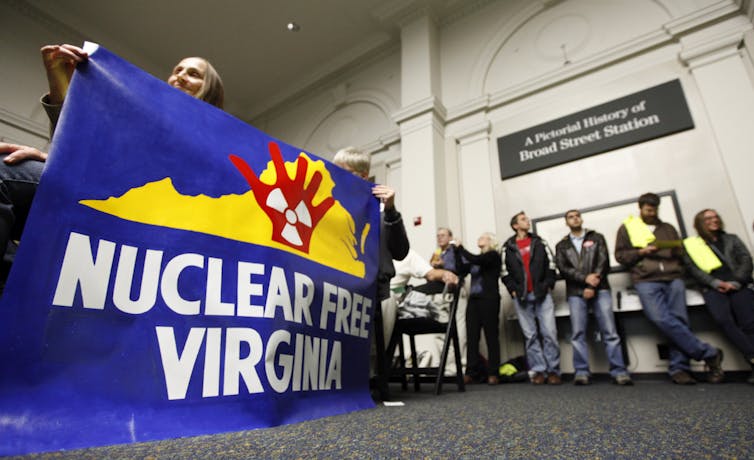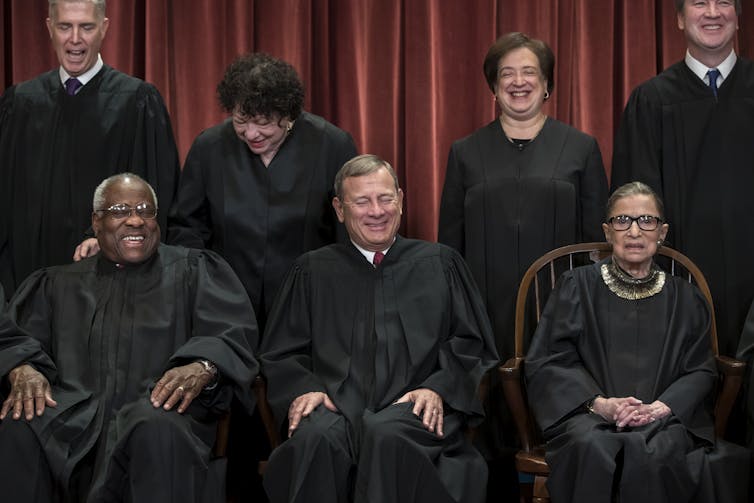
Many Virginians back the decades-old moratorium. AP Photo/Steve Helber
By Cale Jaffe | June 18, 2019
Virginia has the authority to ban uranium mining under state law, even as the federal government regulates the processing of nuclear fuel under the Atomic Energy Act, the Supreme Court has ruled.
Neil Gorsuch, joined by the court’s longest-serving and newest conservatives – Clarence Thomas and Brett Kavanaugh – rejected the idea that Congress’ plan for nuclear enrichment could override Virginia’s decision to prohibit uranium mining altogether. On that point, these three conservatives were in sync with three of the court’s liberals, Ruth Bader Ginsburg, Sonia Sotomayor and Elena Kagan. This remarkably diverse coalition agreed that the “Commonwealth’s mining ban is not preempted” by federal authority. Chief Justice John Roberts filed a dissent.
I have been involved in this case, Virginia Uranium, Inc. v. Warren, in its various iterations for more than a decade. Before joining the faculty at the University of Virginia School of Law, I worked with the Southern Environmental Law Center, an environmental advocacy organization that had raised grave concerns about a proposed uranium mine near the city of Danville.
All three of the opinions published in Virginia Uranium, Inc. v. Warren are likely to prove significant in future environmental battles – both in the courts and in the court of public opinion.
On one level, the justices sketched out the court’s evolving views on the proper balance between federal regulatory power and the rights of states in setting their own policies. Their opinions also challenged some common assumptions about how grassroots environmental advocates can pull together winning political coalitions.
Inverting the states’ rights divide
Conventional wisdom holds that conservatives have excelled at getting judges who support states’ rights on the bench. These judges are broadly seen as distrustful of large federal bureaucracies and enthusiastic about a Tenth Amendment precept that the national government is one of limited powers. Any power not explicitly granted to Congress or the president is, according to the Bill of Rights, “reserved to the states respectively, or to the people.”
So you might have expected all five of the court’s conservative justices to side with the Commonwealth of Virginia and reject an application of the Atomic Energy Act that would extend federal administrative power into an area of traditional state control.
Likewise, you might have guessed that all four liberal justices would have questioned Virginia’s motives in enacting a 1982 moratorium that, according to the uranium mining industry, was allegedly designed to circumvent federal law.
But Gorsuch’s and Ginsburg’s separate, concurring opinions in the uranium case show how difficult the political calculus can be.
While Gorsuch’s lead opinion charted a conservative tack by emphasizing states’ rights, Ginsburg followed a different path that leaned heavily on defending legal precedents.
She also pushed back on the right’s recent interest in revisiting settled case law. Roberts’s dissent is equally important, even though it only garnered two additional votes, from Stephen Breyer, the most moderate member of the liberal camp, and Samuel Alito, a conservative.
Roberts staked out an ideological middle ground between Gorsuch and Ginsburg. Echoing concerns Breyer raised during oral argument, he looked at the “purpose and effect” of Virginia’s mining ban to consider whether the Commonwwealth’s concerns interfered with Congress’ actions.

No joke: Everyone in this photo besides Chief Justice John Roberts joined together to uphold Virginia’s uranium mining ban. AP Photo/J. Scott Applewhite
Economic interests
In its lawsuit, Virginia Uranium claimed that its proposed mining site, about 220 miles southwest of Washington, D.C., could generate US$4.8 billion in net revenue for Virginia businesses.
Uranium oxide, commonly known as yellowcake, can be enriched to produce the fuel that powers the nation’s nuclear reactors. But first it has to be extracted from the ground, which is a monumentally significant undertaking.
Green groups seized on a report published by the National Academy of Sciences, Engineering, and Medicine, which found that uranium mining increases the incidences of cancer, acidification of local waterways, and the emission of soot and smog-forming pollutants from industrial equipment.
Local businesses joined environmentalists in pushing back. The Danville Pittsylvania County Chamber of Commerce opposed the mining project, out of concern about the potential harm to agriculture, tourism and other economic development opportunities.
The state of the law
Under the Atomic Energy Act, states retain jurisdiction over conventional uranium mining. The federal government lacks authority over uranium ore “prior to removal from its place of deposit in nature,” when it is milled into yellowcake.
In our brief to the Supreme Court, we noted that Virginia had narrowly tailored its ban to avoid any conflict with that measure. The state’s moratorium exclusively restricts state-controlled mining and bans only that activity.
Even with the ban on the books, we explained that it still would be legal to process uranium ore under the federal regulatory regime, so long as that ore had been mined out-of-state and trucked into Virginia. In a footnote, Ginsburg shared a similar observation: “The mining ban at issue would not prevent uranium ore mined in North Carolina from being milled, and the resulting tailings stored, in the Commonwealth.”
In other words, Ginsburg focused on the real-world mechanics of how the ban would work.
Gorsuch, on the other hand, kept his eye on broader implications and questioned whether one of the court’s settled judicial doctrines should be retained.
Supreme Court precedent holds that a state’s law can be struck down if it creates an irreconcilable “obstacle” to carrying out a congressional objective. Gorsuch appeared to suggest that such an obstacle might exist when he described Virginia’s mining ban as a “roadblock” that prevents the mining company from even reaching the point where the federal Atomic Energy Act could “kick in.”
The mining company initiated this lawsuit “to overcome that obstacle,” he wrote. Instead of finding the Virginia statute to be preempted, however, Gorsuch found the “obstacle” itself suspect. It’s impossible to pin down, he suggested, without “piling inference upon inference about hidden legislative wishes” – something he refused to do.
Ginsburg was not amused. Gorsuch’s criticisms of judicial doctrine is “inappropriate in an opinion speaking for the Court” because it “sweeps well beyond the confines of this case.”
A roadmap for future advocacy
The farthest-reaching implications of Gorsuch’s discussion only garnered three votes. But it clearly indicated where the Court’s most conservative justices hope to take the law, staving off “the costs to … individual liberty” if courts were to dissect a state’s legislative motives to find a conflict with a federal regulatory program.
Perhaps that points to a playbook for advocacy on other federal actions that environmentalists might find objectionable, such as the Trump administration’s reversal of President Barack Obama’s climate change policies.
Environmentalists are, after all, gaining an appreciation for the value of state initiatives, like Virginia’s mining ban, which can provide a bulwark against regulatory rollbacks.
Editor’s note: Portions of this article appeared in a related article published on Jan. 11, 2019.![]()
Cale Jaffe, Assistant Professor of Law and Director, Environmental and Regulatory Law Clinic, University of Virginia
This article is republished from The Conversation under a Creative Commons license. Read the original article.
